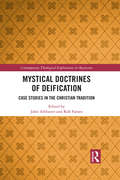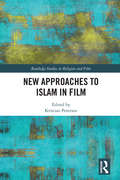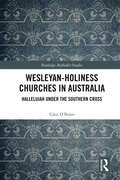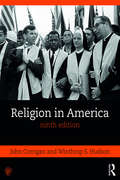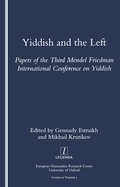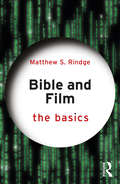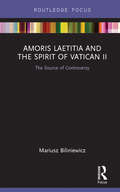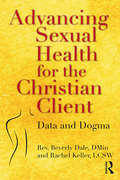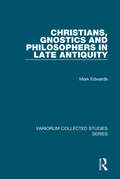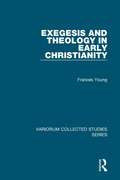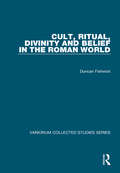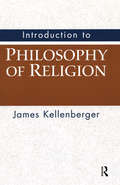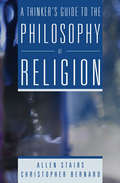- Table View
- List View
Mystical Doctrines of Deification: Case Studies in the Christian Tradition (Contemporary Theological Explorations in Mysticism)
by John Arblaster Rob FaesenThe notion of the deification of the human person (theosis, theopoièsis, deificatio) was one of the most fundamental themes of Christian theology in its first centuries, especially in the Greek world. It is often assumed that this theme was exclusively developed in Eastern theology after the patristic period, and thus its presence in the theology of the Latin West is generally overlooked. The aim of this collection is to explore some Patristic articulations of the doctrine in both the East and West, but also to highlight its enduring presence in the Western tradition and its relevance for contemporary thought. The collection thus brings together a number of capita selecta that focus on the development of theosis through the ages until the Early Modern Period. It is unique, not only in emphasising the role of theosis in the West, but also in bringing to the fore a number of little-known authors and texts, and analysing their theology from a variety of fresh perspectives. Thus, mystical theology in the West is shown to have profound connections with similar concerns in the East and with the common patristic sources. By tying these traditions together, this volume brings new insight to one of mysticism’s key concerns. As such, it will be of significant interest to scholars of religious studies, mysticism, theology and the history of religion.
Mystical Doctrines of Deification: Case Studies in the Christian Tradition (Contemporary Theological Explorations in Mysticism)
by John Arblaster Rob FaesenThe notion of the deification of the human person (theosis, theopoièsis, deificatio) was one of the most fundamental themes of Christian theology in its first centuries, especially in the Greek world. It is often assumed that this theme was exclusively developed in Eastern theology after the patristic period, and thus its presence in the theology of the Latin West is generally overlooked. The aim of this collection is to explore some Patristic articulations of the doctrine in both the East and West, but also to highlight its enduring presence in the Western tradition and its relevance for contemporary thought. The collection thus brings together a number of capita selecta that focus on the development of theosis through the ages until the Early Modern Period. It is unique, not only in emphasising the role of theosis in the West, but also in bringing to the fore a number of little-known authors and texts, and analysing their theology from a variety of fresh perspectives. Thus, mystical theology in the West is shown to have profound connections with similar concerns in the East and with the common patristic sources. By tying these traditions together, this volume brings new insight to one of mysticism’s key concerns. As such, it will be of significant interest to scholars of religious studies, mysticism, theology and the history of religion.
New Approaches to Islam in Film (Routledge Studies in Religion and Film)
by Kristian PetersenMany global film industries fail in expanding the role of Muslims on screen. Too often they produce a dichotomy between "good" and "bad" Muslims, limiting the narrative domain to issues of national security, war, and terrorism. Naturally, much of the previous scholarship on Muslims in film focused on stereotypes and the politics of representation. This collection of essays, from an international panel of contributors, significantly expands the boundaries of discussion around Muslims in film, asking new questions of the archive and magnifying analyses of particular cultural productions. The volume includes the exploration of regional cinemas, detailed analysis of auteurs and individual films, comparison across global cinema, and new explorations that have not yet entered the conversation. The interdisciplinary collection provides an examination of the multiple roles Islam plays in film and the various ways Muslims are depicted. Across the chapters, key intersecting themes arise that push the limits of how we currently approach issues of Muslims in cinema and ventures to lead us in new directions for future scholarship. This book adds new depth to the matrix of previous scholarship by revisiting methodological structures and sources, as well as exploring new visual geographies, transnational circuits, and approaches. It reframes the presiding scholarly conventions in five novel trajectories: considering new sources, exploring new communities, probing new perspectives, charting new theoretical directions, and offering new ways of understanding conflict in cinema. As such, it will be of great use to scholars working in Islamic Studies, Film Studies, Religious Studies, and Media.
New Approaches to Islam in Film (Routledge Studies in Religion and Film)
by Kristian PetersenMany global film industries fail in expanding the role of Muslims on screen. Too often they produce a dichotomy between "good" and "bad" Muslims, limiting the narrative domain to issues of national security, war, and terrorism. Naturally, much of the previous scholarship on Muslims in film focused on stereotypes and the politics of representation. This collection of essays, from an international panel of contributors, significantly expands the boundaries of discussion around Muslims in film, asking new questions of the archive and magnifying analyses of particular cultural productions. The volume includes the exploration of regional cinemas, detailed analysis of auteurs and individual films, comparison across global cinema, and new explorations that have not yet entered the conversation. The interdisciplinary collection provides an examination of the multiple roles Islam plays in film and the various ways Muslims are depicted. Across the chapters, key intersecting themes arise that push the limits of how we currently approach issues of Muslims in cinema and ventures to lead us in new directions for future scholarship. This book adds new depth to the matrix of previous scholarship by revisiting methodological structures and sources, as well as exploring new visual geographies, transnational circuits, and approaches. It reframes the presiding scholarly conventions in five novel trajectories: considering new sources, exploring new communities, probing new perspectives, charting new theoretical directions, and offering new ways of understanding conflict in cinema. As such, it will be of great use to scholars working in Islamic Studies, Film Studies, Religious Studies, and Media.
Wesleyan-Holiness Churches in Australia: Hallelujah under the Southern Cross (Routledge Methodist Studies Series)
by Glen O'BrienMost Wesleyan-Holiness churches started in the US, developing out of the Methodist roots of the nineteenth-century Holiness Movement. The American origins of the Holiness movement have been charted in some depth, but there is currently little detail on how it developed outside of the US. This book seeks to redress this imbalance by giving a history of North American Wesleyan-Holiness churches in Australia, from their establishment in the years following the Second World War, as well as of The Salvation Army, which has nineteenth-century British origins. It traces the way some of these churches moved from marginalised sects to established denominations, while others remained small and isolated. Looking at The Church of God (Anderson), The Church of God (Cleveland), The Church of the Nazarene, The Salvation Army, and The Wesleyan Methodist Church in Australia, the book argues two main points. Firstly, it shows that rather than being American imperialism at work, these religious expressions were a creative partnership between like-minded evangelical Christians from two modern nations sharing a general cultural similarity and set of religious convictions. Secondly, it demonstrates that it was those churches that showed the most willingness to be theologically flexible, even dialling down some of their Wesleyan distinctiveness, that had the most success. This is the first book to chart the fascinating development of Holiness churches in Australia. As such, it will be of keen interest to scholars of Wesleyans and Methodists, as well as religious history and the sociology of religion more generally.
Wesleyan-Holiness Churches in Australia: Hallelujah under the Southern Cross (Routledge Methodist Studies Series)
by Glen O'BrienMost Wesleyan-Holiness churches started in the US, developing out of the Methodist roots of the nineteenth-century Holiness Movement. The American origins of the Holiness movement have been charted in some depth, but there is currently little detail on how it developed outside of the US. This book seeks to redress this imbalance by giving a history of North American Wesleyan-Holiness churches in Australia, from their establishment in the years following the Second World War, as well as of The Salvation Army, which has nineteenth-century British origins. It traces the way some of these churches moved from marginalised sects to established denominations, while others remained small and isolated. Looking at The Church of God (Anderson), The Church of God (Cleveland), The Church of the Nazarene, The Salvation Army, and The Wesleyan Methodist Church in Australia, the book argues two main points. Firstly, it shows that rather than being American imperialism at work, these religious expressions were a creative partnership between like-minded evangelical Christians from two modern nations sharing a general cultural similarity and set of religious convictions. Secondly, it demonstrates that it was those churches that showed the most willingness to be theologically flexible, even dialling down some of their Wesleyan distinctiveness, that had the most success. This is the first book to chart the fascinating development of Holiness churches in Australia. As such, it will be of keen interest to scholars of Wesleyans and Methodists, as well as religious history and the sociology of religion more generally.
Religion in America: Concepts Of American Identity And Mission
by John Corrigan Winthrop HudsonThis comprehensive narrative account of religion in America from the sixteenth century through the present depicts the religious life of the American people within the context of American society. It addresses topics ranging from the European origins of American religious thought and the diversity of religion in America, to the relation of nationhood with religious practice and the importance of race, ethnicity, and gender in American religious history. Split into four parts this textbook covers: Religion in a Colonial Context, 1492-1789 The New Nation, 1789-1865 Years of Midpassage, 1865-1918 Modern America, 1918- Present This new edition has been thoroughly updated to include further discussion of colonialism, religious minorities, space and empire, religious freedom, emotion, popular religion, sexuality, the ascent of the "nones," Islamophobia, and the development of an American mission to the world. With a detailed timeline, illustrations and maps throughout, and an accompanying companion website Religion in America is the perfect introduction for students new to the study of this topic who wish to understand the key themes, places, and people who shaped the world as we know it today.
Religion in America
by John Corrigan Winthrop HudsonThis comprehensive narrative account of religion in America from the sixteenth century through the present depicts the religious life of the American people within the context of American society. It addresses topics ranging from the European origins of American religious thought and the diversity of religion in America, to the relation of nationhood with religious practice and the importance of race, ethnicity, and gender in American religious history. Split into four parts this textbook covers: Religion in a Colonial Context, 1492-1789 The New Nation, 1789-1865 Years of Midpassage, 1865-1918 Modern America, 1918- Present This new edition has been thoroughly updated to include further discussion of colonialism, religious minorities, space and empire, religious freedom, emotion, popular religion, sexuality, the ascent of the "nones," Islamophobia, and the development of an American mission to the world. With a detailed timeline, illustrations and maps throughout, and an accompanying companion website Religion in America is the perfect introduction for students new to the study of this topic who wish to understand the key themes, places, and people who shaped the world as we know it today.
Yiddish and the Left: Papers of the Third Mendel Friedman International Conference on Yiddish
by Gennady Estraikh"For over a century Yiddish served as a major vehicle for expressing left-wing ideas and sensitivities. A language without country, an ""ugly jargon"" despised by assimilationist Jewish bourgeoisie and nationalist Zionists alike, it was embraced as genuine folk idiom by Jewish adherents of socialism and communism worldwide. Following the Holocaust, Yiddish was the primary language of education, culture and propaganda for millions of people on five continents. This volume examines the diversity of relationships between Yiddish and the Left, from the attitude of Yiddish writers to apartheid in South Africa to the vicissitudes of the Yiddish communist press in the Soviet Union and the USA."
Yiddish and the Left: Papers of the Third Mendel Friedman International Conference on Yiddish
by Gennady Estraikh"For over a century Yiddish served as a major vehicle for expressing left-wing ideas and sensitivities. A language without country, an ""ugly jargon"" despised by assimilationist Jewish bourgeoisie and nationalist Zionists alike, it was embraced as genuine folk idiom by Jewish adherents of socialism and communism worldwide. Following the Holocaust, Yiddish was the primary language of education, culture and propaganda for millions of people on five continents. This volume examines the diversity of relationships between Yiddish and the Left, from the attitude of Yiddish writers to apartheid in South Africa to the vicissitudes of the Yiddish communist press in the Soviet Union and the USA."
Bible and Film: The Basics (The Basics)
by Matthew S. RindgeBible and Film: The Basics is a concise, accessible, and illuminating introduction to the study of Bible and Film. The book introduces non-specialists to the essential content in Bible and Film, and to some of the most common and important methods Bible and Film scholars use. Questions asked throughout the book include: How do films (re)interpret and illuminate biblical texts? How do films appropriate, reconfigure, and transform biblical texts? How does a film's treatment of biblical texts help interpret and illuminate the film? This book examines various types of interplay between film and the Bible. The theme of ‘Bible on film’ is explored through Hebrew Bible epics including The Prince of Egypt and Noah, and Jesus films such as The Last Temptation of Christ and Son of Man. The theme ‘Bible in film’ is analyzed through films including Mary Magdalene, Magnolia, Pulp Fiction, and The Book of Eli. Films that ‘reimagine the Bible’ include Ex Machina, mother!, and The Tree of Life; unusual Jesus figures in Pan’s Labyrinth, Dogville, and Donnie Darko are also explored. ‘Film as Bible’ considers films such as To the Wonder, Silence, and Parasite. A conclusion examines television shows such as Dekalog, The West Wing, The Handmaid’s Tale, and God on Trial. With a glossary of key terms and suggestions for further reading throughout, this book is an ideal starting point for anyone seeking a full introduction to religion and film, bible and film, bible and popular culture, and theology and film.
Bible and Film: The Basics (The Basics)
by Matthew S. RindgeBible and Film: The Basics is a concise, accessible, and illuminating introduction to the study of Bible and Film. The book introduces non-specialists to the essential content in Bible and Film, and to some of the most common and important methods Bible and Film scholars use. Questions asked throughout the book include: How do films (re)interpret and illuminate biblical texts? How do films appropriate, reconfigure, and transform biblical texts? How does a film's treatment of biblical texts help interpret and illuminate the film? This book examines various types of interplay between film and the Bible. The theme of ‘Bible on film’ is explored through Hebrew Bible epics including The Prince of Egypt and Noah, and Jesus films such as The Last Temptation of Christ and Son of Man. The theme ‘Bible in film’ is analyzed through films including Mary Magdalene, Magnolia, Pulp Fiction, and The Book of Eli. Films that ‘reimagine the Bible’ include Ex Machina, mother!, and The Tree of Life; unusual Jesus figures in Pan’s Labyrinth, Dogville, and Donnie Darko are also explored. ‘Film as Bible’ considers films such as To the Wonder, Silence, and Parasite. A conclusion examines television shows such as Dekalog, The West Wing, The Handmaid’s Tale, and God on Trial. With a glossary of key terms and suggestions for further reading throughout, this book is an ideal starting point for anyone seeking a full introduction to religion and film, bible and film, bible and popular culture, and theology and film.
Amoris Laetitia and the spirit of Vatican II: The Source of Controversy (Routledge Focus on Religion)
by Mariusz BiliniewiczAmoris Laetitia, Pope Francis' post-synodal exhortation on love in the family, turned out to be one of the most controversial documents of the Magisterium of the Catholic Church in recent decades. It was published in April 2016 following the two "Synods of Bishops on the Family" held in 2014 and 2015. The document brought division amongst the Catholic hierarchy, theologians and pastors and nearly two years after its publication the exact meaning of the document and its implications for the Church are still a matter of dispute. A number of prelates present at the Synods indicated that these gatherings were animated by "the spirit of Vatican II." This work links the notion of "the spirit of Vatican II" with Amoris Laetitia and it argues that a hermeneutics of interpretation of the Second Vatican Council which focuses on following "the spirit of the Council" is the hermeneutics which can be, and in the future most likely will be, the predominant way of interpreting and implementing Amoris Laetitia. This book aims to provide a contribution to this hotly debated topic in the field of Catholic theology.
Amoris Laetitia and the spirit of Vatican II: The Source of Controversy (Routledge Focus on Religion)
by Mariusz BiliniewiczAmoris Laetitia, Pope Francis' post-synodal exhortation on love in the family, turned out to be one of the most controversial documents of the Magisterium of the Catholic Church in recent decades. It was published in April 2016 following the two "Synods of Bishops on the Family" held in 2014 and 2015. The document brought division amongst the Catholic hierarchy, theologians and pastors and nearly two years after its publication the exact meaning of the document and its implications for the Church are still a matter of dispute. A number of prelates present at the Synods indicated that these gatherings were animated by "the spirit of Vatican II." This work links the notion of "the spirit of Vatican II" with Amoris Laetitia and it argues that a hermeneutics of interpretation of the Second Vatican Council which focuses on following "the spirit of the Council" is the hermeneutics which can be, and in the future most likely will be, the predominant way of interpreting and implementing Amoris Laetitia. This book aims to provide a contribution to this hotly debated topic in the field of Catholic theology.
Advancing Sexual Health for the Christian Client: Data and Dogma
by Beverly Dale Rachel KellerAdvancing Sexual Health for the Christian Client is an essential toolkit for professionals working at the intersection of Christian belief and sexual health. In this book, Beverly Dale and Rachel Keller deconstruct potentially harmful Christian beliefs around sexuality to support clients stuck in sexual guilt, shame and fear. Combining the experience of an ordained Christian clergy with a certified sexologist, this guide promotes a new approach to sex and faith for therapists, which will help their clients to reconcile a belief in God’s love with sexual knowledge and fulfilment. Grounded in historical and cultural contexts, and drawing from both academic research and scriptural exegesis, the authors offer practical clinical applications and interventions to enable clients to re-examine their sexual beliefs in a way that encourages sexual healing. By understanding the goals of a sex-positive, body-positive Christianity, professionals can find a common language with the person of faith and build an effective therapeutic relationship. This book will be a key point of reference for any sex therapist, educator, or student looking to integrate faith-based concepts into their approach.
Advancing Sexual Health for the Christian Client: Data and Dogma
by Beverly Dale Rachel KellerAdvancing Sexual Health for the Christian Client is an essential toolkit for professionals working at the intersection of Christian belief and sexual health. In this book, Beverly Dale and Rachel Keller deconstruct potentially harmful Christian beliefs around sexuality to support clients stuck in sexual guilt, shame and fear. Combining the experience of an ordained Christian clergy with a certified sexologist, this guide promotes a new approach to sex and faith for therapists, which will help their clients to reconcile a belief in God’s love with sexual knowledge and fulfilment. Grounded in historical and cultural contexts, and drawing from both academic research and scriptural exegesis, the authors offer practical clinical applications and interventions to enable clients to re-examine their sexual beliefs in a way that encourages sexual healing. By understanding the goals of a sex-positive, body-positive Christianity, professionals can find a common language with the person of faith and build an effective therapeutic relationship. This book will be a key point of reference for any sex therapist, educator, or student looking to integrate faith-based concepts into their approach.
Christians, Gnostics and Philosophers in Late Antiquity (Variorum Collected Studies)
by Mark EdwardsGnosticism, Christianity and late antique philosophy are often studied separately; when studied together they are too often conflated. These articles set out to show that we misunderstand all three phenomena if we take either approach. We cannot interpret, or even identify, Christian Gnosticism without Platonic evidence; we may even discover that Gnosticism throws unexpected light on the Platonic imagination. At the same time, if we read writers like Origen simply as Christian Platonists, or bring Christians and philosophers together under the porous umbrella of "monotheism", we ignore fundamental features of both traditions. To grasp what made Christianity distinctive, we must look at the questions asked in the studies here, not merely what Christians appropriated but how it was appropriated. What did the pagan gods mean to a Christian poet of the fifth century? What did Paul quote when he thought he was quoting Greek poetry? What did Socrates mean to the Christians, and can we trust their memories when they appeal to lost fragments of the Presocratics? When pagans accuse the Christians of moral turpitude, do they know more or less about them than we do? What divides Augustine, the disenchanted Platonist, from his Neoplatonic contemporaries? And what God or gods await the Neoplatonist when he dies?
Christians, Gnostics and Philosophers in Late Antiquity (Variorum Collected Studies)
by Mark EdwardsGnosticism, Christianity and late antique philosophy are often studied separately; when studied together they are too often conflated. These articles set out to show that we misunderstand all three phenomena if we take either approach. We cannot interpret, or even identify, Christian Gnosticism without Platonic evidence; we may even discover that Gnosticism throws unexpected light on the Platonic imagination. At the same time, if we read writers like Origen simply as Christian Platonists, or bring Christians and philosophers together under the porous umbrella of "monotheism", we ignore fundamental features of both traditions. To grasp what made Christianity distinctive, we must look at the questions asked in the studies here, not merely what Christians appropriated but how it was appropriated. What did the pagan gods mean to a Christian poet of the fifth century? What did Paul quote when he thought he was quoting Greek poetry? What did Socrates mean to the Christians, and can we trust their memories when they appeal to lost fragments of the Presocratics? When pagans accuse the Christians of moral turpitude, do they know more or less about them than we do? What divides Augustine, the disenchanted Platonist, from his Neoplatonic contemporaries? And what God or gods await the Neoplatonist when he dies?
Exegesis and Theology in Early Christianity (Variorum Collected Studies)
by Frances YoungThis collection of articles first brings together a number of working papers which were significant in the development of Frances Young's understanding of patristic exegesis, studies not included in her ground-breaking book, Biblical Exegesis and the Formation of Christian Culture (1997), though paving the way for that work. Then comes a selection of papers on theology, church order and methodology, the whole collection constantly returning to themes such as the fundamental connection between theology and exegesis, the significant role of reflection on language, metaphor and symbol, and the creative interaction of early Christianity with its cultural and intellectual environment. These studies demonstrate the author's scholarly approach to patristic material, whereby careful attention is paid to actual texts from the past; but they also reveal the groundwork for her own theological explorations in the very different intellectual environment of the present.
Exegesis and Theology in Early Christianity (Variorum Collected Studies)
by Frances YoungThis collection of articles first brings together a number of working papers which were significant in the development of Frances Young's understanding of patristic exegesis, studies not included in her ground-breaking book, Biblical Exegesis and the Formation of Christian Culture (1997), though paving the way for that work. Then comes a selection of papers on theology, church order and methodology, the whole collection constantly returning to themes such as the fundamental connection between theology and exegesis, the significant role of reflection on language, metaphor and symbol, and the creative interaction of early Christianity with its cultural and intellectual environment. These studies demonstrate the author's scholarly approach to patristic material, whereby careful attention is paid to actual texts from the past; but they also reveal the groundwork for her own theological explorations in the very different intellectual environment of the present.
Cult, Ritual, Divinity and Belief in the Roman World (Variorum Collected Studies)
by Duncan FishwickThe papers assembled in this selection of studies range in subject matter from early Judaic magic to an inscribed monument of the Neo-Classical period. The principal emphasis of the collection is nevertheless on religious developments under the High Roman Empire: problems arising from the interpretation of oriental cults imported from the Hellenistic East but primarily the development of imperial cult, the one universal religion of the empire before the coming of Christianity. The essays divide into five categories: Divinity and Power; The Imperial Numen; The Imperial Cult: Review and Discussion; Rituals and Ceremonies; Ainigmata. The titles of the individual articles speak for themselves but readers may also find the preface of interest in so far as it sets out the author's ideas on the controversial nature of the emperor's divinity. While this is a topic deserving of a book in its own right, the preface together with the points raised by individual studies within the overall framework may go some way to repairing this defficiency.
Cult, Ritual, Divinity and Belief in the Roman World (Variorum Collected Studies)
by Duncan FishwickThe papers assembled in this selection of studies range in subject matter from early Judaic magic to an inscribed monument of the Neo-Classical period. The principal emphasis of the collection is nevertheless on religious developments under the High Roman Empire: problems arising from the interpretation of oriental cults imported from the Hellenistic East but primarily the development of imperial cult, the one universal religion of the empire before the coming of Christianity. The essays divide into five categories: Divinity and Power; The Imperial Numen; The Imperial Cult: Review and Discussion; Rituals and Ceremonies; Ainigmata. The titles of the individual articles speak for themselves but readers may also find the preface of interest in so far as it sets out the author's ideas on the controversial nature of the emperor's divinity. While this is a topic deserving of a book in its own right, the preface together with the points raised by individual studies within the overall framework may go some way to repairing this defficiency.
Introduction to Philosophy of Religion: Readings
by James KellenbergerUsing various and competing religious sensibilities, Introduction to the Philosophy of Religion helps students work through the traditional material and their own religious questions.
Introduction to Philosophy of Religion
by James KellenbergerUsing various and competing religious sensibilities, Introduction to the Philosophy of Religion helps students work through the traditional material and their own religious questions.
A Thinker's Guide to the Philosophy of Religion
by Allen StairsWith an approachable, reader-friendly style, A Thinker's Guide to the Philosophy of Religion provides up-to-date themes in contemporary, analytic philosophy of religion. This provocative collection of readings stimulates clear thinking and careful attention to the reasons for taking up views on religious questions.
